Spleen
| Spleen | |
|---|---|
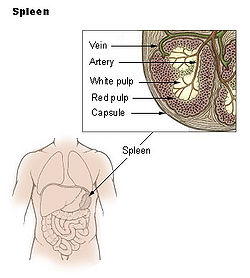 |
|
| Spleen | |
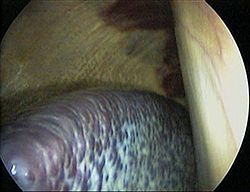 |
|
| Laparoscopic view of a horse's spleen (the purple and grey mottled organ) | |
| Latin | splen, lien |
| Gray's | subject #278 1282 |
| Artery | Splenic artery |
| Vein | Splenic vein |
| Nerve | Splenic plexus |
| Precursor | Mesenchyme of dorsal mesogastrium |
| MeSH | Spleen |
| Dorlands/Elsevier | Spleen |
The spleen (from Greek "σπλήν" - splen[1]) is an organ found in virtually all vertebrate animals with important roles in regard to red blood cells and the immune system.[2] In humans, it is located in the left upper quadrant of the abdomen. It removes old red blood cells and holds a reserve of blood in case of hemorrhagic shock while also recycling iron.[3] It synthesizes antibodies in its white pulp and removes antibody-coated bacteria along with antibody-coated blood cells by way of blood and lymph node circulation. The spleen is purple and gray.[3][4] Recently, it has been found to contain in its reserve half of the body's monocytes within the red pulp. These monocytes, upon moving to injured tissue (such as the heart), turn into dendritic cells and macrophages while promoting tissue healing.[5][6][7] It is one of the centers of activity of the reticuloendothelial system and can be considered analogous to a large lymph node, as its absence leads to a predisposition toward certain infections.[8]
Contents |
Anatomy
The spleen, in healthy adult humans, is approximately 11 centimetres (4.3 in) in length. It usually weighs 200 grams (7.1 oz) and lies beneath the 9th to the 12th thoracic ribs.[9]
Like the thymus, the spleen possesses only efferent lymphatic vessels.
The spleen is part of the lymphatic system.
The germinal centers are supplied by arterioles called penicilliary radicles.[10]
The spleen is unique in respect to its development within the gut. While most of the gut viscera are endodermally derived (with the exception of the neural-crest derived suprarenal gland), the spleen is derived from mesenchymal tissue.[11] Specifically, the spleen forms within, and from, the dorsal mesentery. However, it still shares the same blood supply — the celiac trunk — as the foregut organs.
Function
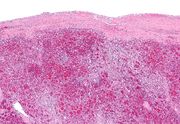
| Area | Function | Composition |
| red pulp | Mechanical filtration of red blood cells. Reserve of monocytes[5] |
|
| white pulp | Active immune response through humoral and cell-mediated pathways. | Composed of nodules, called Malpighian corpuscles. These are composed of:
|
Other functions of the spleen are less prominent, especially in the healthy adult:
- Production of opsonins, properdin, and tuftsin.
- Creation of red blood cells. While the bone marrow is the primary site of hematopoiesis in the adult, the spleen has important hematopoietic functions up until the fifth month of gestation. After birth, erythropoietic functions cease, except in some hematologic disorders. As a major lymphoid organ and a central player in the reticuloendothelial system, the spleen retains the ability to produce lymphocytes and, as such, remains an hematopoietic organ.
- Storage of red blood cells and other formed elements. In horses roughly 30% of the red blood cells are stored there. The red blood cells can be released when needed.[12] In humans, it does not act as a reservoir of blood cells.[13] It can also store platelets in case of an emergency.
- Storage of half the body's monocytes so that upon injury they can migrate to the injured tissue and transform into dendritic cells and macrophages and so assist wound healing.[5]
Effect of removal
Surgical removal causes:[6]
- modest increases in circulating white blood cells and platelets,
- diminished responsiveness to some vaccines,
- increased susceptibility to infection by bacteria and protozoa; in particular, there is an increased risk of sepsis from polysaccharide encapsulated bacteria.
Surgical removal is a fairly non-invasive procedure and, in emergency circumstances, can be removed without anesthetic. A 28-year follow up of 740 veterans of World War II who has removed their own on the battlefield found that those who had been splenectomised showed a significant excess of mortality from pneumonia (6 from an expected 1.3) and a significant excess of mortality from ischaemic heart disease (4.1 from an expected 3) but not from other conditions.[14]
Disorders
Disorders include splenomegaly, where the spleen is enlarged for various reasons, and asplenia, where the spleen is not present or functions abnormally.
Etymology and cultural views
The word spleen comes from the Greek σπλήν, and is the idiomatic equivalent of the heart in English, i.e. to be good-spleened (εὔσπλαγχνος) means to be good-hearted or compassionate.[15]
In English the word spleen was customary during the period of the 18th century. Authors like Richard Blackmore or George Cheyne employed it to characterize the hypocondriacal and hysterical affections.[16][17]
In French, "splénétique" refers to a state of pensive sadness or melancholy. It has been popularized by the poet Charles Baudelaire (1821–1867) but was already used before in particular to the Romantic literature (18th century). The word for the organ is "la rate."
The connection between spleen (the organ) and melancholy (the temperament) comes from the humoral medicine of the ancient Greeks. One of the humours (body fluid) was the black bile, secreted by the spleen organ and associated with melancholy. In contrast, the Talmud (tractate Berachoth 61b) refers to the spleen as the organ of laughter while possibly suggesting a link with the humoral view of the organ. In the eighteenth- and nineteenth-century England, women in bad humour were said to be afflicted by the spleen, or the vapours of the spleen. In modern English, "to vent one's spleen" means to vent one's anger, e.g. by shouting, and can be applied to both males and females. Similarly, the English term "splenetic" is used to describe a person in a foul mood.
In Chinese, the spleen '脾 (pí)' counts as the seat of one's temperament and is thought to influence the individual's willpower. Analogous to "venting one's spleen", "發脾氣" is used as an expression for getting angry, although in the view of Traditional Chinese Medicine, the view of "脾" does not correspond to the anatomical "spleen". "脾" is a conceptual functional group that mainly has regards to digestion which, in some scholars' opinions, corresponds to the function of the pancreas.
Variation among vertebrates
In cartilagenous and ray-finned fish the spleen is normally a somewhat elongated organ, consisting primarily of red pulp, with only a small amount of white pulp. In lungfish, the spleen is not a distinct organ as it actually lies inside the serosal lining of the intestine. In many amphibians, especially frogs, it takes on the more rounded form and there is often a greater quantity of white pulp.[18]
In reptiles, birds, and mammals, white pulp is always relatively plentiful, and in the latter two groups, the spleen is typically rounded, although it adjusts its shape somewhat to the arrangement of the surrounding organs. In the great majority of vertebrates, the spleen continues to produce red blood cells throughout life; it is only in mammals that this function is lost in the adult. Many mammals possess tiny spleen-like structures known as haemal nodes throughout the body, which presumably have the same function as the spleen proper.[18] The spleens of aquatic mammals are in some ways dissimilar to those of fully land dwelling mammals. In general the spleens of aquatic mammals are bluish in colour. In cetaceans and manatees it tends to be quite small, but in deep diving pinnipeds it can be quite massive, owing to its function of storing red blood cells.
The only vertebrates lacking a spleen are the lampreys and hagfishes. Even in these animals, there is a diffuse layer of haematopoeitic tissue within the gut wall, which has a similar structure to red pulp, and is presumably homologous with the spleen of higher vertebrates.[18]
See also
- Marginal zone
Additional images
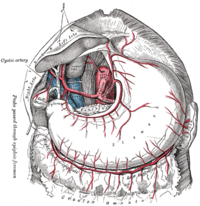 The celiac artery and its branches. |
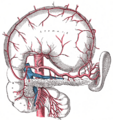 The celiac artery and its branches. |
 Horizontal disposition of the peritoneum in the upper part of the abdomen. |
 Transverse section through the middle of the first lumbar vertebra. |
 The duodenum and pancreas. |
 The visceral surface of the spleen. |
 Transverse section of the spleen, showing the trabecular tissue and the splenic vein and its tributaries. |
 Transverse section of the human spleen, showing the distribution of the splenic artery and its branches. |
 Section of the spleen, showing the termination of the small blood vessels. |
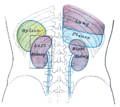 Back of lumbar region, showing surface markings for kidneys, ureters, and spleen. |
 Side of thorax, showing surface markings for bones, lungs (purple), pleura (blue), and spleen (green). |
 Lymphatic system |
References
- ↑ σπλήν, Henry George Liddell, Robert Scott, A Greek-English Lexicon, on Perseus Digital Library
- ↑ Spleen, Internet Encyclopedia of Science
- ↑ 3.0 3.1 Mebius RE, Kraal G. (2005). Structure and function of the spleen. Nat Rev Immunol. 5(8):606-16. PMID 16056254
- ↑ Loscalzo, Joseph; Fauci, Anthony S.; Braunwald, Eugene; Dennis L. Kasper; Hauser, Stephen L; Longo, Dan L. (2008). Harrison's principles of internal medicine. McGraw-Hill Medical. ISBN 9780071466339.
- ↑ 5.0 5.1 5.2 Swirski FK, Nahrendorf M, Etzrodt M, Wildgruber M, Cortez-Retamozo V, Panizzi P, Figueiredo J-L, Kohler RH, Chudnovskiy A, Waterman P, Aikawa E, Mempel TR, Libby P, Weissleder R, Pittet MJ. (2009). Identification of Splenic Reservoir Monocytes and Their Deployment to Inflammatory Sites. Science, 325: 612-616. doi:10.1126/science.1175202
- ↑ 6.0 6.1 Jia T, Pamer EG. (2009). Dispensable But Not Irrelevant. Science, 325:549-550. doi:10.1126/science.1178329
- ↑ Finally, the Spleen Gets Some Respect By NATALIE ANGIER, New York Times, August 3, 2009
- ↑ Brender, MD, Erin; Allison Burke, MA, illustrator, Richard M. Glass, MD, editor (2005-11-23). "Spleen Patient Page" (PDF). Journal of the American Medical Association (American Medical Association) 294 (20): 2660. http://jama.ama-assn.org/cgi/reprint/294/20/2660.pdf. Retrieved 2008-03-20.
- ↑ Spielmann, Audrey L.; David M. DeLong, Mark A. Kliewer (1 January 2005). "Sonographic Evaluation of Spleen Size in Tall Healthy Athletes". American Journal of Roentgenology (American Roentgen Ray Society) 2005 (184): 45–49. PMID 15615949. http://www.ajronline.org/cgi/content/abstract/184/1/45. Retrieved 2008-09-09.
- ↑ thefreedictionary.com - penicilliary radicles
- ↑ Vellguth, Swantje; Brita von Gaudecker, Hans-Konrad Müller-Hermelink. "The development of the human spleen". Cell and Tissue Research (Springer Berlin / Heidelberg) 242 (3): 579–592. http://www.springerlink.com/content/q231303t1455j524/. Retrieved 2009-02-14.
- ↑ Carey, Bjorn (May 5, 2006). "Horse science: What makes a Derby winner - Spleen acts as a 'natural blood doper,' scientist says". MSNBC.com (Microsoft). http://www.msnbc.msn.com/id/12648465/. Retrieved 2006-05-09.
- ↑ Tao Le. First Aid for the Basic Sciences: General Principles. Page 460.
- ↑ Robinette CD, Fraumeni JF Jr. (1977). Splenectomy and subsequent mortality in veterans of the 1939-45 war. Lancet. Jul 16;2(8029):127-9. PMID 69206 doi:10.1016/S0140-6736(77)90132-5
- ↑ Robertson's Word Pictures of the New Testament, commentary on 1 Peter 3:8
- ↑ Cheyne, George: The English Malady; or, A Treatise of Nervous Diseases of All Kinds, as Spleen, Vapours, Lowness of Spirits, Hypochondriacal and Hysterical Distempers with the Author's own Case at large, Dublin, 1733. Facsimile ed., ed. Eric T. Carlson, M.D., 1976, Scholars' Facsimiles & Reprints, ISBN 9780820112817;
- ↑ Blackmore, Richard: Treatise of the spleen and vapors. London, 1725
- ↑ 18.0 18.1 18.2 Romer, Alfred Sherwood; Parsons, Thomas S. (1977). The Vertebrate Body. Philadelphia, Pennsylvania: Holt-Saunders International. pp. 410–411. ISBN 0-03-910284-X.
External links
- SUNY Figs 38:03-01 - "The visceral surface of the spleen."
- SUNY Anatomy Image 7881
- "spleen" from Encyclopædia Britannica Online
- Spleen and Lymphatic System, Kidshealth.org (American Academy of Family Physicians)
- Spleen Diseases from MedlinePlus
- "Finally, the Spleen Gets Some Respect" New York Times piece on the spleen
|
|||||||||||||||||||||||||||||||||||||||||||||||||||||||||||||
|
|||||||||||||||||||||||||||||||||